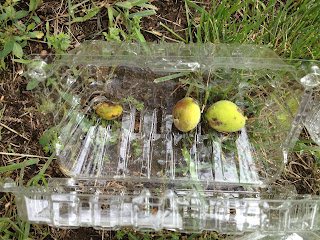Predator Protection Trial and Error
This spring we tried a few new things to keep our crops safe from animals and insects that would like to swipe more than their fair share. One promising idea was using plastic fruit containers to keep squirrels away from our ripening tree fruits. But after all of our blustery days of downpours this month, most of those containers ended up on the ground:
I wouldn't mind just snapping them back in place, but the real problem is that they often brought the fruit down with them. I'm not sure if this is a flaw in the system overall, or more of an issue with apricots being kind of delicate in hanging on the tree (at least, this has been true for us — it's not the first time we've accidentally knocked one off the branch before it was ripe).
Alas, the only one we have left on the tree is this one that never made it into a container in the first place. I thought about removing the remaining containers last weekend, but decided to ride out the experiment instead.
Oops.
It could well be that this idea would work better for tougher fruits, and ones that are farther along in their development. I haven't seen any signs of squirrels near these trees so far, though, so I think I'll stay my hand until we notice any damage. It could be that the presence of a cat is enough to keep them at bay, since this isn't such easy pickin's anymore.
Another idea that had some problems:
This is the little toothpick fence we tried to keep cutworms away from our leeks. This Pinterest-sponsored idea was that the toothpicks would keep the cutworm from wrapping around the leeks. As you can see, this did not work.
Now, to be fair, there are plenty of leeks with toothpicks around them that were not eaten, but we also don't have a whole bed full of cutworms, either. So while I guess that I can't be entirely sure it's not been effective on the other leeks, my gut feeling is that this isn't the way to go, especially given how tedious it is. Collars all the way from now on.
I also think we'll cool it on the winter cover cropping, since these are likely to harbor the larvae that overwinter and emerge in the spring to eat everything up. I'm sure the chickens got most of them, which is why we haven't lost more than just a handful of plants to these guys. In the future, we'll have a smaller area of winter cropping to make sure that the chickens can get a good amount of time on those spots to eat grubs and till the soil thoroughly for us, which will probably be our best protection of all against cutworms.
Looks like the lesson here is to use your animals to help you garden: cats vs. squirrels, chickens vs. cutworms. Thanks, guys!






Comments
Post a Comment